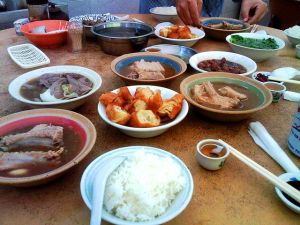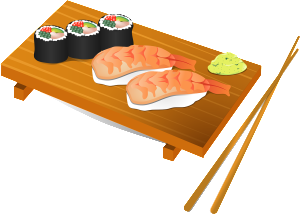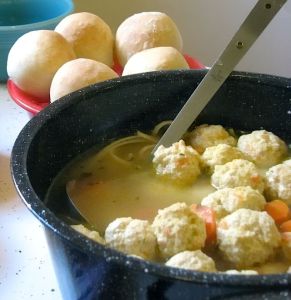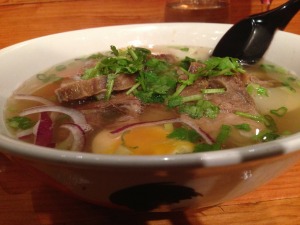Traditional Chinese dishes are quite different from what we are used to seeing at a Western Chinese restaurant or buffet. Traditionally, Chinese people do not eat a lot of meat or greasy food. Their diet mostly consists of steamed rice, vegetables, and soups, that don’t have a lot of calories and fat in them. You don’t want to increase the risk of heart disease and obesity from your diet.
Features of a traditional Chinese diet
Preparing Chinese food requires plenty of experience and expertise. When Chinese food is prepared, it is almost always cut into bite-size pieces. You will hardly ever find knives at a traditional Chinese dinner table. Chinese foods also emphasizes the right combination of vegetables and condiments. Chinese cooks add different flavors and spices to food, not only for taste, but also for  several health benefits associated with different condiments and spices.
several health benefits associated with different condiments and spices.
The main feature of a traditional diet is plenty of steamed rice, vegetables, and plant-based foods, and low amounts of animal-based proteins. Traditional Chinese cooking has also received praise for its disease-fighting abilities. Chinese cooking is not only delicious, but also aimed towards boosting the body’s natural disease fighting capabilities. Traditional Chinese food isused in a delicious way as a therapy, which boosts the immune system and harmonizes the body with the seasons. Traditional disease-fighting foods areprepared with strategic blends of spices and flavors, which makethem delicious and healthy at the same time.
Traditionally, vegetables in Chinawere prepared by lightly steaming, or sometimes through stir-fry. Starches like rice, noodles, and dumplings most commonly accompanied these vegetables. Meat and fish were served in much smaller amounts and were prepared in a different way, compared to western diets.
When they cook their meals, adding spices like garlic and ginger isoften a way to aid digestion. Many foods are also used for therapy and to maintain a balance between elements of life. A sweet food is thought to bring back your mood, while a sour food will help you with digestion and stomach problems.
Traditional Chinese diet therapy
 Traditional Chinese food is prepared with the intention of boosting your body’s natural healing power, immune system, and increasing longevity. The ingredients in Chinese meals have many medicinal values as well. They are also great for boosting energy, reducing body fat and keeping blood pressure and diabetes under control. The traditional way of cooking Chinese food uses only unsaturated oils, without using any dairy products such as cheese, butter, or cream. Eating low amounts of meat also cuts the amount of animal fat intake and cholesterol. (Health Benefits of Chinese Foods)
Traditional Chinese food is prepared with the intention of boosting your body’s natural healing power, immune system, and increasing longevity. The ingredients in Chinese meals have many medicinal values as well. They are also great for boosting energy, reducing body fat and keeping blood pressure and diabetes under control. The traditional way of cooking Chinese food uses only unsaturated oils, without using any dairy products such as cheese, butter, or cream. Eating low amounts of meat also cuts the amount of animal fat intake and cholesterol. (Health Benefits of Chinese Foods)
Control obesity with a Chinese diet
With traditional Chinese food, you don’t need to count calories, as with other foods you mayusually eat. In fact, the Chinese think of food as a way to get nourishment, and there are no ingredients to potentially cause disease or gain weight;their foods contain no sugar and are low in fat.
According to PatrickHolford, a British nutritionist, author, and founder of the Institute for Optimum Nutrition in London, says, “The latest research into weight loss shows that calorie-controlled, low-fat diets are less effective than low glycemic load diets, which is exactly what a traditional Chinese diet is.”
 Ian Marber, a food and nutrition expert and nutritional therapist, clarifies it with an example. Compare the calorie levels of aDiet Coke and an avocado. Which is healthier? “It’s a no-brainer” he says. Although an avocado has 340 calories compared to the Diet Coke’s only one calorie, “the avocado supplies you with monounsaturated fats and omega-6, which actually help increase metabolic rate.” (Source: Use your noodle: The real Chinese diet is so healthy it could solve the West’s obesity crisis – Healthy Living – Health & Families – The Independent)
Ian Marber, a food and nutrition expert and nutritional therapist, clarifies it with an example. Compare the calorie levels of aDiet Coke and an avocado. Which is healthier? “It’s a no-brainer” he says. Although an avocado has 340 calories compared to the Diet Coke’s only one calorie, “the avocado supplies you with monounsaturated fats and omega-6, which actually help increase metabolic rate.” (Source: Use your noodle: The real Chinese diet is so healthy it could solve the West’s obesity crisis – Healthy Living – Health & Families – The Independent)
Many different types of foods can be used in treating different types of diseases. The proper diet for a patient depends on several factors, such as the nature of the illness, climatic condition, constitution of the patient and type of disease. (TCM -What is Food Therapy?)
Controlling diseases with food
Eating raw fruits and vegetables has many health benefits. Eating a plant-based, living diet improves your health and fitness level dramatically. Boiled foodshavevery low toxic levels. A whole fruit and plant-based diet can get rid of many of the risks of diseases that are associated with food. We often get sick because we eat processed food with high levels of fat, sugar, or toxic  ingredients in them.
ingredients in them.
Antioxidants found in green vegetables and fruits fight free radicals, detoxify our body, and actually slow down the aging process. They also fight heart disease and cancer. Traditional Chinese medicine practitioners prescribe foods as well as herbs and roots as medical treatments. Chili, for example, is prescribed to promote digestion, while green tea, ginger, and lemon juice, are given as cold medicine, and many other foods such as garlic, and other spices are used for medical purposes.
Eat until you are full
Rice allows you to eat until you are full, without a high calorie intake. Rice is high in fiber and low in calories; an ideal staple food, which is the basic ingredient of a Chinese diet. Skipping meals and eating less carbohydrates and more proteins or fats won’t help you to lose weight. Holford says: “Provided that a meal has a high intake of fiber-rich vegetables and a balance of protein and carbohydrate, which a typical Chinese meal would, then you should eat until you are full.”
Benefits of a liquid diet
Chinese meals are also never complete without soup or a soup-based dish. Dry foods urge you to drink water, which lacks in nutrients. Drinking soup made with rice, vegetables and fish will fill you up easily in a very nutritious way, giving you a supply of vitamins, minerals, and essential carbohydrates and proteins. 
Traditional Chinese foods are filled with greatness and nutrients of nature. Many of these foods were developed as early as 2,000 BC. The Huangdi Neijing, which was written around 300 BC, was most important in forming the basis of Chinese food therapy. (Chinese food therapy).
Traditionally, Chinese foods target health and wellness by increasing and decreasing the body’s metabolism. Chinese foods are often found beneficial in losing weight, controlling heart disease, blood pressure, diabetes, and keeping body fitness levels high. They will also fill you up with nutrients without excessive fat or calories. Some Chinese foods are also known to supply you with high levels of antioxidants, making your immune system stronger, detoxifying your body, and giving you more disease-fighting capabilities. Some natural remedies and medications are also useful in fighting diseases in natural ways, without using any chemicals.
Learn more about the benefits and clinical healing power of Traditional Chinese food from our next bi-weekly Huddle/ Webinar guest, Giuseppe La Manna, CEO/CTO – EcoLogix Sustainable Business Solutions, LLC.We will also get to know him and hear about his life experiences. Please join us for what is sure to be an informative and eye-opening hour!
Source: Nourish the Planet
,




You have Japanese foods representing Chinese diet? Please understand the Japanese raw sushi is not consumed by the Chinese traditionalists. The Chinese do not eat raw fish like the Japanese. Most of our foods are either fried or fully-cooked and steamed.
There are a few things you may want to change on this page. It could be found offensive to different people. I would suggest replaceing the pictures of the raw fish and sushi. Traditional Chinese cooking and meals do not include raw meats. You can typically find this in a Japanese diet. Though, you have good information on this page. Images other than those of the sushi and raw fish are pretty accurate.
Next time just be more careful with what images you use to help your readers. This information could hopefully help you on other posts like these.